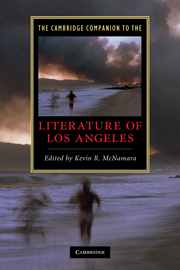Book contents
- Frontmatter
- Introduction: landmarks
- 1 The literature of the Californios
- 2 The Anglo invention of Los Angeles
- 3 LA fiction through mid-century
- 4 British expatriates and German exiles in 1930s-1940s Los Angeles
- 5 Postwar Los Angeles: suburban Eden and the fall into history
- 6 Los Angeles and the African-American literary imagination
- 7 Pacific Rim city: Asian-American and Latino literature
- 8 The literature of urban rebellion
- 9 City of sleuths
- 10 Los Angeles’ science fiction futures
- 11 Hollywood fictions
- 12 The Southland on screen
- 13 Scenes and movements in Southern California poetry
- 14 Surf, sagebrush, and cement rivers: Reimagining nature in Los Angeles
- 15 Essaying Los Angeles
- Guide to further reading
- Index
3 - LA fiction through mid-century
Published online by Cambridge University Press: 28 May 2010
- Frontmatter
- Introduction: landmarks
- 1 The literature of the Californios
- 2 The Anglo invention of Los Angeles
- 3 LA fiction through mid-century
- 4 British expatriates and German exiles in 1930s-1940s Los Angeles
- 5 Postwar Los Angeles: suburban Eden and the fall into history
- 6 Los Angeles and the African-American literary imagination
- 7 Pacific Rim city: Asian-American and Latino literature
- 8 The literature of urban rebellion
- 9 City of sleuths
- 10 Los Angeles’ science fiction futures
- 11 Hollywood fictions
- 12 The Southland on screen
- 13 Scenes and movements in Southern California poetry
- 14 Surf, sagebrush, and cement rivers: Reimagining nature in Los Angeles
- 15 Essaying Los Angeles
- Guide to further reading
- Index
Summary
Upton Sinclair's Oil! (1927) begins as a dream of speed. Sinclair calls his opening chapter “The Ride” and bases it on a trip he and his wife Craig took with a big oilman who wanted to buy two lots they owned on Signal Hill, near Long Beach. He “asked us to come and look at a ranch he offered in exchange,” Craig writes in Southern Belle (1957). “So we let him drive us in a big fast car, breaking all the speed laws.” The property they saw that day would become the Watkins Ranch in San Elido, the site of Dad's big strike in Oil! and a place that would stimulate in Sinclair a prescient depiction of the soon-to-be-developed oil field near Bakersfield at Kettleman Hills. “The road ran, smooth and flawless,” Oil! begins, “precisely fourteen feet wide, the edges trimmed as if by shears, a ribbon of grey concrete, rolled out over the valley by a giant hand. The ground went in long waves, a slow ascent and then a sudden dip; you climbed, and went swiftly over - but you had no fear, for you knew the magic ribbon would be there, clear of obstructions, unmarred by bump or scar, waiting the passage of inflated rubber wheels revolving seven times a second.” / Thrown into “a storm of motion,” Sinclair's reader can only come along for the ride. Like Dad, his “business is with the things that lie before” him, “and the past is past.” As impatient a driver as he is deliberate a businessman, Dad wants “a speed law turned inside out,” and dreams of a California where it will one day be illegal, on such roads, to drive less than forty miles an hour. “You were racing with the other people, who were always threatening to get your oil.”
- Type
- Chapter
- Information
- The Cambridge Companion to the Literature of Los Angeles , pp. 35 - 48Publisher: Cambridge University PressPrint publication year: 2010

